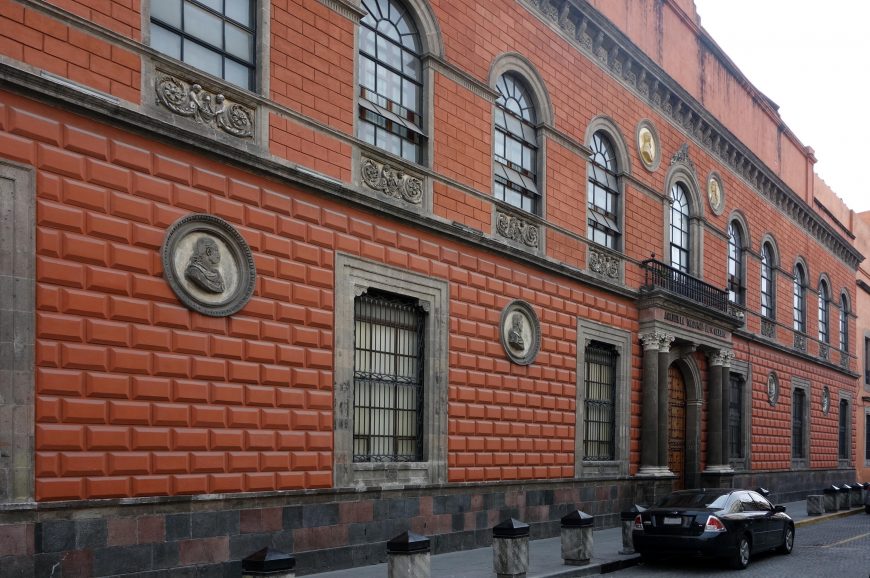José María Velasco, The Valley of Mexico from the Santa Isabel Mountain Range (Valle de México desde el cerro de Santa Isabel),1875, oil on canvas, 137.5 x 226 cm (Museo Nacional de Arte, INBA, Mexico City)
[0:00] [music]
Dr. Steven Zucker: [0:05] We’re in the National Museum of Art in Mexico City, and we’re looking at an amazing, very large canvas by José María Velasco. It is this panoramic image of the Valley of Mexico.
Dr. Lauren Kilroy-Ewbank: [0:18] The painting is about the land.
Dr. Zucker: [0:20] About the history of the land. In the center and slightly to the right, we see Mexico City itself. It can be barely seen, but it’s clear enough so that we can just make out the towers of the cathedral of Mexico City.
Dr. Kilroy-Ewbank: [0:33] José María Velasco is using light and shadow to guide our eye in this wonderful zigzag motion so that we recede from the foreground all the way into the back, to the city itself.
Dr. Zucker: [0:46] Let’s talk about how we get there. In the very foreground, we have this incredible specificity, and this is an artist who is known to take real care with botanical and meteorological phenomena.
[0:57] He’s studying plants, he’s studying the geology, and he’s studying cloud formations, trying to get this right. Our eye first lands on this little vignette of a mother and two children, who seem to be walking away from the city, walking back into nature.
Dr. Kilroy-Ewbank: [1:12] There’s this dramatic shadow that starts in the bottom right-hand corner that arches its way across the foreground [and] that helps lead our eye around the light so that we go around this foreground precipice.
[1:25] Then we begin to find our way to the middle ground, to where we first see structures that are associated with the Hill of Tepeyac, where the basilica to the Virgin of Guadalupe is, where she miraculously appeared to Juan Diego in 1531.
Dr. Zucker: [1:40] One of the great spiritual moments and one of the great spiritual places in Mexico. This painting is in some ways a celebration of great moments in Mexican history and its spiritual roots.
Dr. Kilroy-Ewbank: [1:51] Beyond that we’re seeing roads that are in part the ancient Aztec causeway, that lead us to the heart of Mexico City. We see some of the effects of industrialization, but only hints of it, dust maybe being kicked up by machinery or by carriages. All of this is set against the receding lake.
Dr. Zucker: [2:10] A lake that had once surrounded the city that we see in the distance when it was the Aztec capital, but is now being pushed off by increasing development.
[2:18] We see this transitory moment, not only in terms of human development but also in terms of the formations of the sky. We see clouds, we see a rainstorm off to the right that beautifully balance[s] the two volcanic peaks that we see on the left.
Dr. Kilroy-Ewbank: [2:33] Those volcanic peaks are important to the history of Mexico. They are the volcanoes Popocatépetl and Iztaccíhuatl, thought to have been related to two individuals, two lovers from the Aztec period. They were important in the mytho-history of Mexico.
Dr. Zucker: [2:49] Even as this is a celebration of Mexico, its present, its history, its mythology, it’s also very much a painting of the 19th century. This is a painting that is deeply informed by the Romanticism of people like John Constable in England or Caspar David Friedrich in Germany.
[3:06] This is an international movement that is looking back to nature in all of its grandeur, the way in which it can evoke a spiritual power, but in a historical moment that is interested in the scientific.
Dr. Kilroy-Ewbank: [3:18] That’s where it begins to depart more from those Romantic qualities of the landscape. José María Velasco was interested in the scientific observation of nature, to try to make it as exact as possible.
[3:30] He’s painting this as a member of the Academy of San Carlos, this academic institution here in Mexico City. His teacher is an Italian immigrant who is training and teaching landscape painting.
Dr. Zucker: [3:43] One of the techniques that the artist uses is to paint this in a studio so that he can get the exact detail that he wants in a controlled circumstance, but to base the painting on numerous sketches that he does in the landscape. We’re fortunate to have some of the sketches that he produced while hiking in these mountains.
Dr. Kilroy-Ewbank: [4:01] This is one of numerous paintings that the artist completed that show the valley of Mexico from this perspective. In fact, as we stand in the gallery, we can see some of these other paintings, including another from almost the same vantage point, but in this one, from a slightly different angle, a bit higher up. But we don’t have any human figures.
Dr. Zucker: [4:22] Instead, in the foreground we see an eagle that seems to have just flown off a cactus. In Mexico, this is potent imagery.
Dr. Kilroy-Ewbank: [4:30] It could just be an eagle flying off a cactus. But for Mexican history, this is related to the Aztec migration story, where they ended up establishing their capital city of Tenochtitlán, or modern-day Mexico City, on an island in the middle of the lake after they saw an eagle perched atop a cactus.
Dr. Zucker: [4:49] This symbol is a central emblem of the Mexican flag, can be found on Mexican currency, and remains an important way in which modern Mexico ties itself back to its Aztec origins.
Dr. Kilroy-Ewbank: [5:01] How we can understand these paintings by José María Velasco is in part due to this increasing urgency for a Mexican national identity that has been ongoing since independence in 1821.
[5:12] [music]
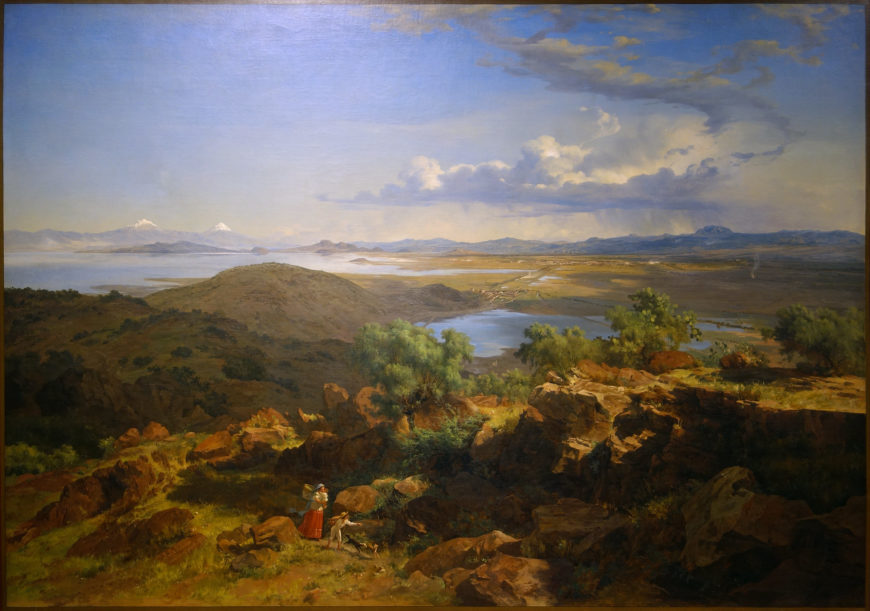
José María Velasco, The Valley of Mexico from the Santa Isabel Mountain Range (Valle de México desde el cerro de Santa Isabel), 1875, oil on canvas, 137.5 x 226 cm (Museo Nacional de Arte, INBA, Mexico City, photo: Steven Zucker, CC BY-NC-SA 2.0)
Academy of San Carlos
Did you know that the first art school in the Americas was established in Mexico City in the late eighteenth century? Creole artists (of European descent born in the Spanish Americas) in preceding decades had failed to convince the Spanish king to create a pedagogical artistic institution. Nevertheless, by the end of the eighteenth century, the Royal Academy of San Carlos (Real Academia de San Carlos) was established. It was modeled after the Art Academy of San Fernando in Madrid, and consequently, a new chapter of Mexican art history began.
Pure landscape
This important school fostered Romantic and Neoclassical aesthetics through previously unexplored genres of painting. For example, beginning in the nineteenth century, students emerging from the new school at the Academy began to illustrate local vistas of the Valley of Mexico. The development of these images offered the perfect opportunity for artists to explore the Romantic qualities of “pure landscape,” which in Mexico, through the teachings of the Italian professor Eugenio Landesio, emerged as a popular genre in the Academy. However, and as observed in Velasco’s The Valley of Mexico from the Hillside of Santa Isabel (above), the valley represented much more than a mere opportunity to practice this newly established genre of painting. This imagery offered an opportunity to highlight symbols of patriotism valuable to a newly independent society.
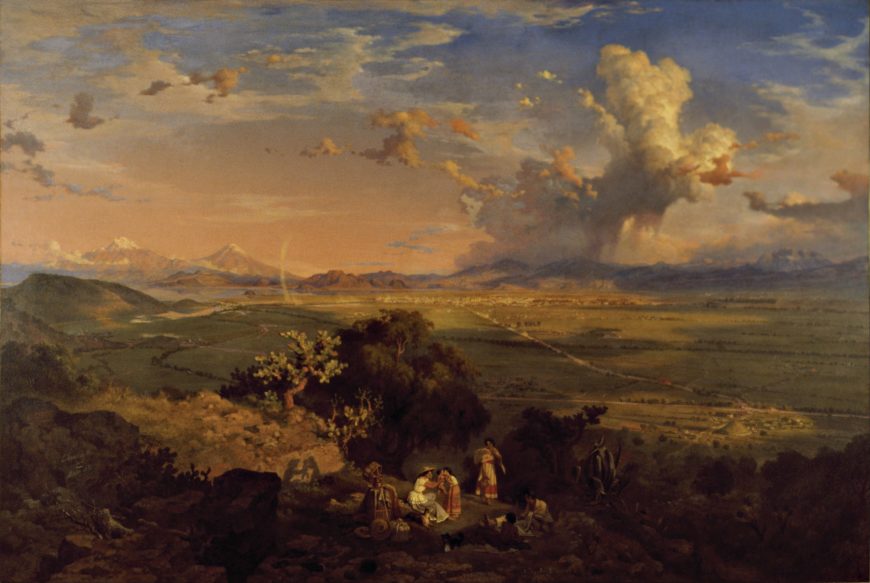
Eugene Landesio, The Valley of Mexico from the Hill in Tenayo, 1870, oil on canvas, 150.5 x 213 cm (Museo Nacional de Arte, INBA, Mexico City)
After the 1821 war of independence (from Spain), Mexico sought to establish its identity through artistic endeavors. The development of the practice of national landscape painting was part of the dictator López de Santa Anna’s efforts to re-establish the art academy after decades of neglect following the formation of Mexico as an independent nation. The Italian artist Eugenio Landesio (who was a well-regarded artist in Mexico) was appointed as the academy’s professor of perspective and landscape painting in 1855. His mentorship and his experience uniting ancient and contemporary Roman historical subjects in his canvasses forever changed the history of Mexican landscape painting.
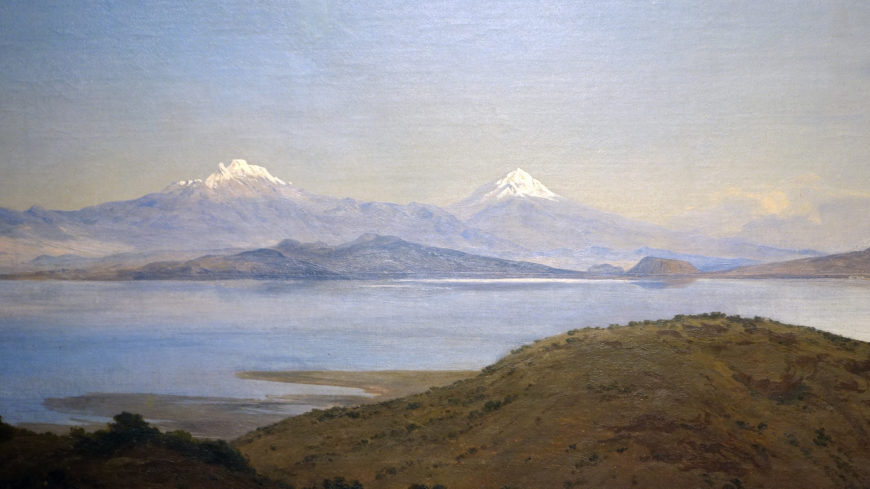
The volcanic peaks Popocatepetl and Iztacchihuatl (detail), José María Velasco, The Valley of Mexico from the Santa Isabel Mountain Range (Valle de México desde el cerro de Santa Isabel), 1875, oil on canvas, 137.5 x 226 cm (Museo Nacional de Arte, INBA, Mexico City, photo: Steven Zucker, CC BY-NC-SA 2.0)
Monumentality
While Eugenio Landesio and his contemporaries had created similar landscapes of the Valley, Velasco presented a monumentality and an open quality to his images that surpassed compositions such as El Valle de Mexico desde el Cerro del Tenayo (above) created by his Italian mentor only a few years earlier. Velasco’s compositions united pre-Hispanic symbols and contemporary national sentiments. For example, the white peaks that predominate his vistas are the Popocatepetl and Iztacchihuatl volcanoes. For centuries the land’s romantic topology has captured the imagination of Mexicans. Prior to the arrival of the Spanish to the Valley of Mexico in 1519, these two volcanoes were the main characters of a legendary ill-fated love between an Aztec princess (Iztacchihuatl, or “white woman”) and a courageous warrior (Popocatepetl, or “smoking mountain”).
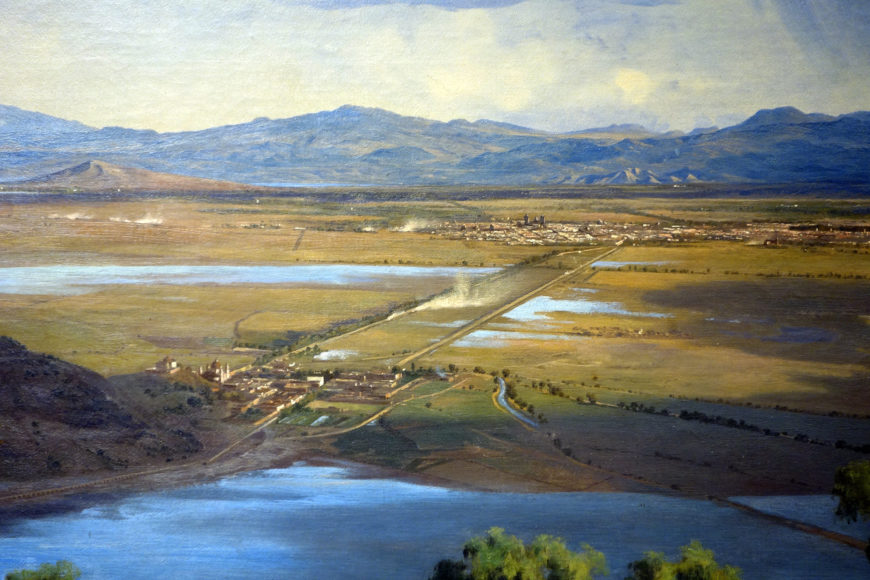
Basilica of Guadalupe (bottom left), edge of Lake Texcoco (middle ground) and Mexico City (detail), José María Velasco, The Valley of Mexico from the Santa Isabel Mountain Range, 1875, oil on canvas, 137.5 x 226 cm (Museo Nacional de Arte, INBA, Mexico City, photo: Steven Zucker, CC BY-NC-SA 2.0)
Towards the composition’s background, the spectator can admire the receding waters of Lake Texcoco and the contours of Mexico City. The ancient Aztec capital of Tenochtitlan was founded in the middle of this lake in 1325. This was a familiar site for Velasco, given that the artist’s home was located at the foot of the small hill shown in the middle of the canvas. This unassuming hill was also an important sacred colonial site where the Virgin of Guadalupe first appeared to the indigenous man Juan Diego in 1531. The artist is known to have painted in this location many times. This version of The Valley of Mexico from the Hillside of Santa Isabel is perhaps the most celebrated of a dozen or so images with the same subject done by the artist between 1875 and 1892. At one point, the brushstrokes that form the peaks of the snow-covered volcanoes, the rock formations and other details were done from memory, making it possible for the artist to change and manipulate the details of the landscape as he saw fit.
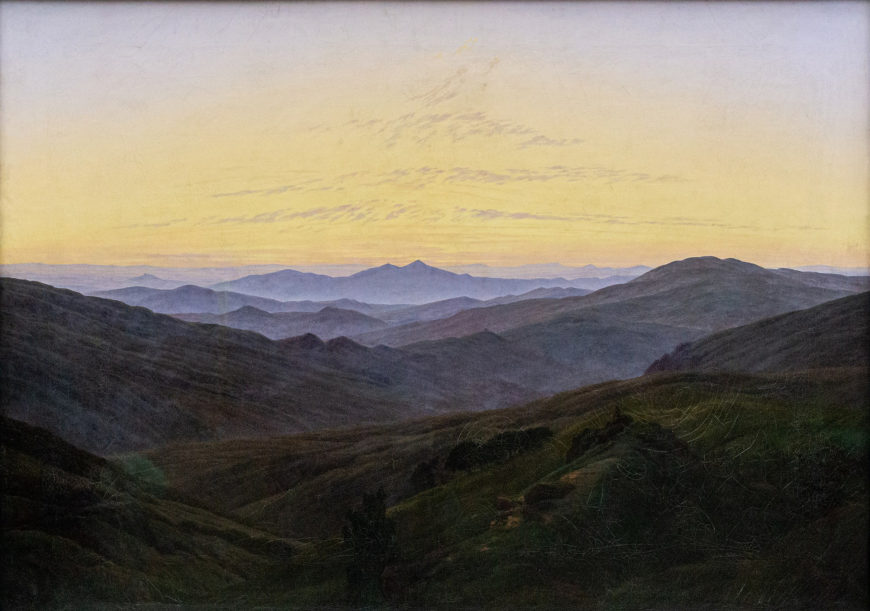
Caspar David Friedrich, The Riesengebirge Mountains, 1835, oil on canvas, 73.5 x 102.5 cm (Alte Nationalgalerie, Berlin)
German Romanticism
The Valley of Mexico from the Hillside of Santa Isabel can be viewed as a re-interpretation of the common late eighteenth-century German subject, “pastoral idylls,” where a sense of poetic harmony and daily life were united. In the tradition of artists such as Casper David Friedrich (above) and Joseph Anton Koch, Velasco introduces his figures (below) not as mere staffage, or accessories enhancing the rest of the artwork, but as key components behind the composition’s poetics. Similar to his German predecessors, Velasco explored the romantic relationship between human figures and the scenery they inhabit. Two indigenous individuals are presented in transit from the city to the country, reflecting a romantic, yet difficult socio-economic relationship between people and their ancestral land. The figures’ indigenous garments intrinsically relate to the national iconography displayed throughout the image. In the words of the German poet Johann Christoph Friedrich von Schiller, the figures in a landscape must represent “a humanity reconciled with itself . . . nature purified, raised to its highest moral dignity…the ideal beauty applied to real life.” [1] Velasco has produced an image where national pride, romantic poetry, and daily life blend to transform the Valley of Mexico into a Romantic masterpiece.
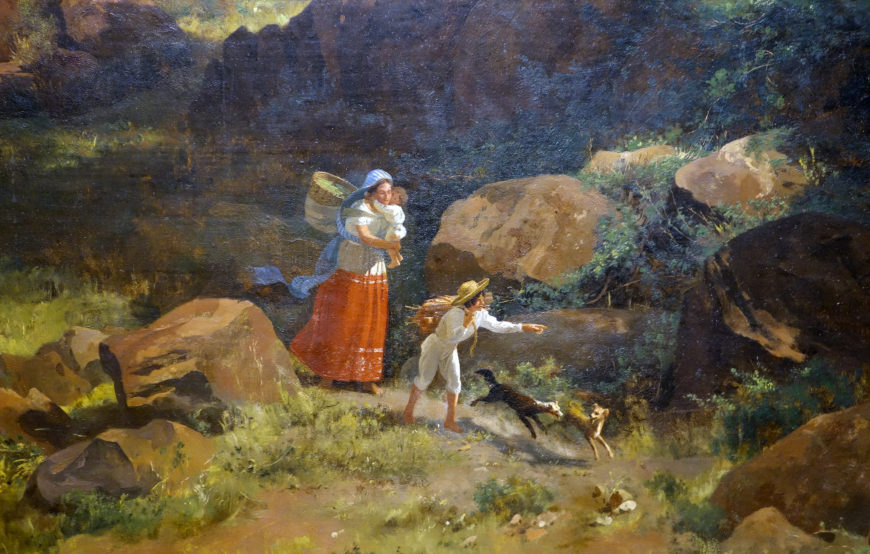
Figures in foreground (detail), José María Velasco, The Valley of Mexico from the Santa Isabel Mountain Range, 1875, oil on canvas, 137.5 x 226 cm (Museo Nacional de Arte, INBA, Mexico City, photo: Steven Zucker, CC BY-NC-SA 2.0)
Overall, The Valley of Mexico from the Hillside of Santa Isabel represents an important period in the development of Mexico’s national identity and an important chapter in the history of Mexican art. Velasco’s landscapes became symbols of the nation as they represented Mexico in several World Fairs. The union of romantic European sensibilities and the historical allegories observed in his compositions won him important recognition in Chicago, Paris, and Philadelphia in the late nineteenth century.

